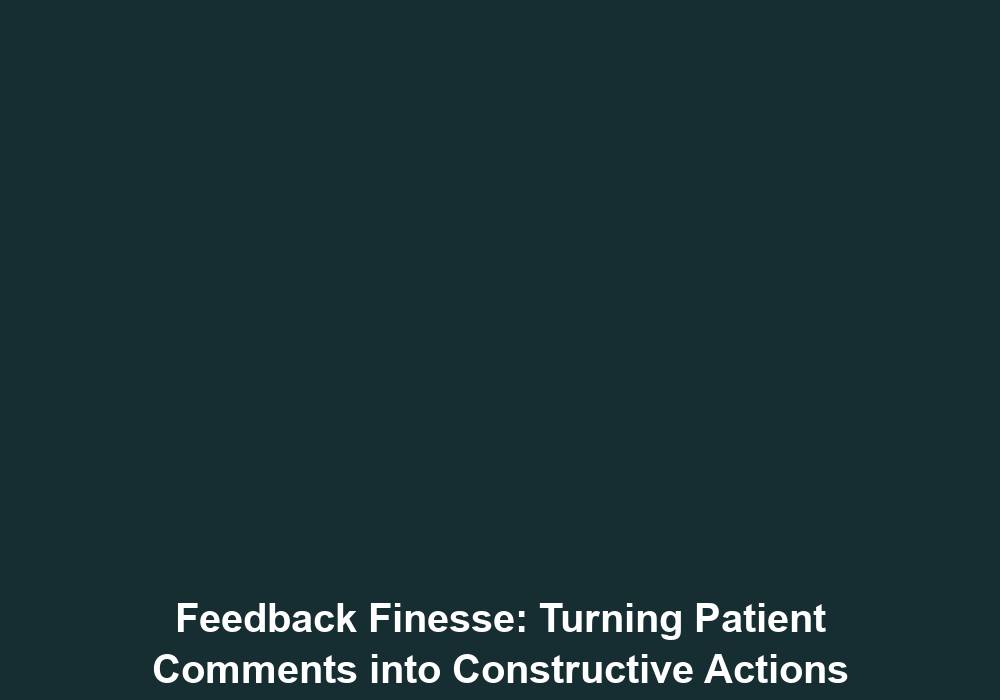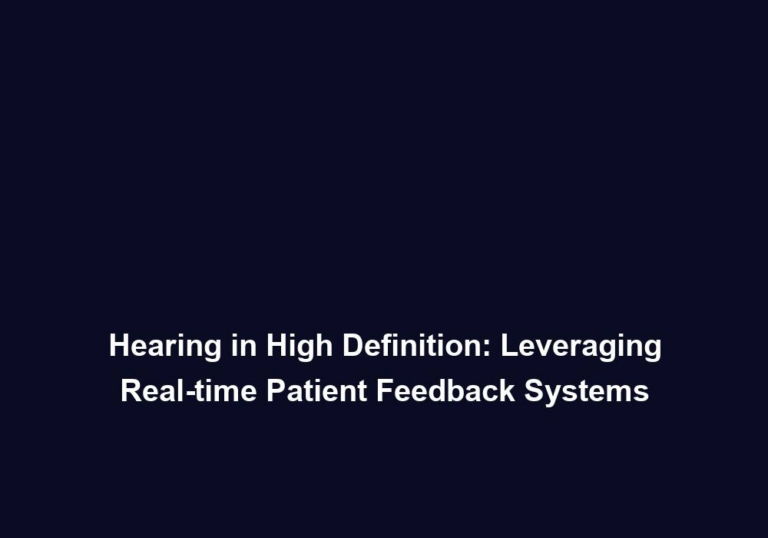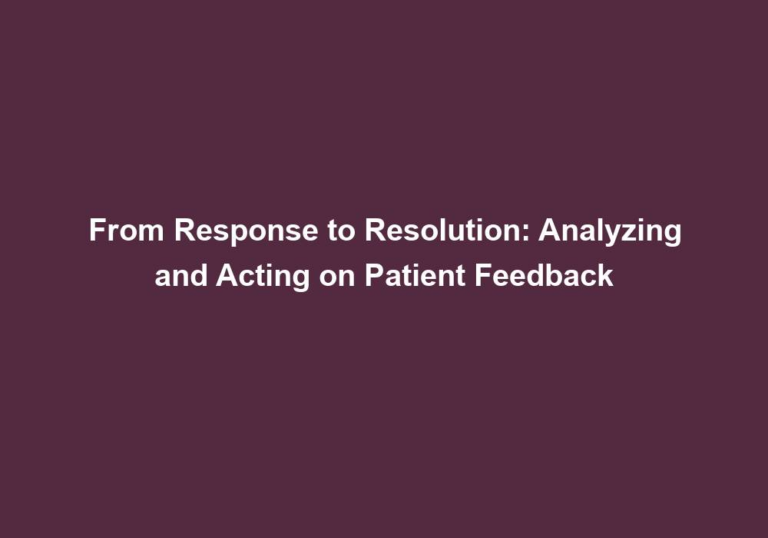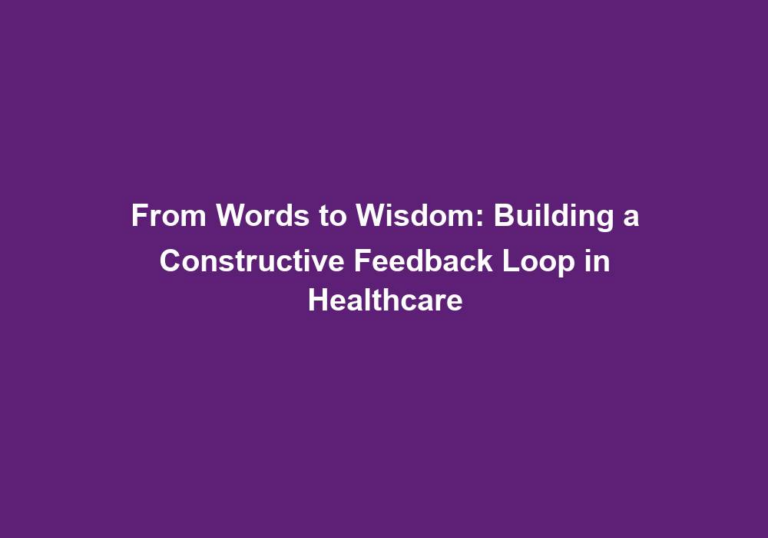Instant Insights: Harnessing Real-time Feedback Systems for Enhanced Patient Care
In today’s fast-paced healthcare environment, it is crucial for healthcare organizations to leverage real-time feedback systems to ensure enhanced patient care. These systems provide valuable insights into patient experiences, enabling healthcare providers to make informed decisions and improve the quality of care provided. This article explores the benefits, challenges, and implementation strategies of harnessing real-time feedback systems in healthcare settings.
Why Real-time Feedback Systems Matter
Real-time feedback systems allow healthcare organizations to gather immediate feedback from patients, caregivers, and staff. This instant access to feedback is invaluable in improving patient care as it enables organizations to identify and address issues promptly. By capturing feedback in the moment, healthcare providers can proactively resolve problems, improve satisfaction levels, and enhance patient outcomes.
Real-time feedback systems matter because:
-
They enable timely issue resolution: Real-time feedback systems empower healthcare organizations to address issues promptly. By identifying and resolving problems in real-time, providers can prevent them from escalating and negatively impacting patient care. This leads to improved patient safety and satisfaction.
-
They improve patient satisfaction: By actively seeking feedback, healthcare organizations show patients that their opinions matter. This fosters a patient-centered environment, leading to increased satisfaction levels. Real-time feedback allows providers to identify areas of improvement and take immediate action to address patient concerns, ultimately enhancing the overall patient experience.
-
They enhance the quality of care: Real-time feedback systems provide valuable insights into the patient experience, allowing healthcare providers to identify areas for improvement. By addressing these areas, organizations can enhance the quality of care provided to patients. These systems help healthcare providers to continuously monitor and improve their services, resulting in better patient outcomes.
-
They promote staff engagement and empowerment: Involving staff in the real-time feedback process empowers them to take ownership of patient experiences. By collecting feedback from both patients and staff, organizations can foster a culture of continuous improvement and engagement. Staff members feel valued and are more motivated to deliver high-quality care when they are actively involved in the feedback process.
-
They enable data-driven decision making: Real-time feedback systems generate large amounts of data, enabling healthcare organizations to make data-driven decisions. By analyzing this data, organizations can identify trends, patterns, and areas for improvement. This data-driven approach allows for more effective resource allocation, improved patient outcomes, and better overall organizational performance.
Benefits of Real-time Feedback Systems
Real-time feedback systems offer numerous benefits to healthcare organizations, including:
-
Timely Issue Resolution: Real-time feedback systems enable healthcare organizations to address issues promptly. By identifying and resolving problems in real-time, providers can prevent them from escalating and negatively impacting patient care. This leads to improved patient safety and satisfaction.
-
Improved Patient Satisfaction: By actively seeking feedback, healthcare organizations show patients that their opinions matter. This fosters a patient-centered environment, leading to increased satisfaction levels. Real-time feedback allows providers to identify areas of improvement and take immediate action to address patient concerns, ultimately enhancing the overall patient experience.
-
Enhanced Quality of Care: Real-time feedback systems provide valuable insights into the patient experience, allowing healthcare providers to identify areas for improvement. By addressing these areas, organizations can enhance the quality of care provided to patients. These systems help healthcare providers to continuously monitor and improve their services, resulting in better patient outcomes.
-
Staff Engagement and Empowerment: Involving staff in the real-time feedback process empowers them to take ownership of patient experiences. By collecting feedback from both patients and staff, organizations can foster a culture of continuous improvement and engagement. Staff members feel valued and are more motivated to deliver high-quality care when they are actively involved in the feedback process.
-
Data-Driven Decision Making: Real-time feedback systems generate large amounts of data, enabling healthcare organizations to make data-driven decisions. By analyzing this data, organizations can identify trends, patterns, and areas for improvement. This data-driven approach allows for more effective resource allocation, improved patient outcomes, and better overall organizational performance.
Real-time feedback systems offer a range of benefits that contribute to improved patient care and organizational performance. By leveraging these systems, healthcare organizations can enhance patient satisfaction, ensure high-quality care, and make informed decisions based on data-driven insights.
Challenges in Implementing Real-time Feedback Systems
While the benefits of real-time feedback systems are evident, there are several challenges that organizations may face during implementation. These challenges include:
-
Technical Infrastructure: Implementing real-time feedback systems requires a robust technical infrastructure capable of collecting, storing, and analyzing large amounts of data. Organizations need to ensure they have the necessary technology and resources in place to support these systems. This may involve investing in advanced data collection and analysis tools, as well as ensuring sufficient bandwidth and storage capacity.
-
Integration with Existing Systems: Real-time feedback systems should seamlessly integrate with existing systems, such as electronic health records (EHRs) and patient satisfaction surveys. Ensuring smooth integration can be a complex task that requires careful planning and collaboration. Organizations need to consider the compatibility of different systems and ensure proper data flow between them to avoid duplication or loss of information.
-
Data Privacy and Security: Healthcare organizations must prioritize data privacy and security when implementing real-time feedback systems. Patient feedback contains sensitive information that needs to be protected to comply with privacy regulations. Organizations need to implement robust security measures, including encryption, access controls, and regular security audits, to safeguard patient data and maintain compliance with relevant privacy laws.
-
Staff Training and Adoption: It is crucial to train staff on how to use real-time feedback systems effectively. Healthcare providers need to be educated on the importance of collecting feedback, interpreting data, and implementing changes based on insights gained. Training programs should be comprehensive and ongoing to ensure staff members are comfortable and proficient in utilizing the feedback systems.
-
Overcoming Resistance to Change: Implementing real-time feedback systems may encounter resistance from staff who are accustomed to traditional feedback methods. Organizations need to address this resistance by highlighting the benefits, providing ongoing support, and involving staff in the decision-making process. Effective change management strategies, such as communication, training, and incentives, can help overcome resistance and promote adoption of the new feedback systems.
Implementing Real-time Feedback Systems
To successfully implement real-time feedback systems, healthcare organizations should consider the following strategies:
-
Define Objectives: Clearly define the objectives and goals of implementing real-time feedback systems. Identify the specific areas of patient care that need improvement and establish measurable targets. This will help align the implementation process with the organization’s overall goals and ensure that the feedback systems are focused on addressing the most critical issues.
-
Choose the Right Technology: Select a real-time feedback system that aligns with the organization’s technical infrastructure and requirements. Consider factors such as data storage, analysis capabilities, and integration with existing systems. The chosen technology should be scalable, user-friendly, and capable of handling the expected volume of feedback data.
-
Ensure Data Privacy and Security: Implement robust data privacy and security measures to protect patient information. Adhere to relevant regulations, such as the Health Insurance Portability and Accountability Act (HIPAA). This may involve encryption of data, access controls, regular security audits, and staff training on privacy practices.
-
Provide Staff Training: Train healthcare providers on how to utilize real-time feedback systems effectively. Educate staff on the importance of collecting feedback, interpreting data, and implementing changes based on insights gained. Training programs should be comprehensive and ongoing to ensure staff members are comfortable and proficient in utilizing the feedback systems.
-
Promote Engagement: Encourage staff, patients, and caregivers to actively participate in the feedback process. Create a culture that values feedback and recognizes its role in improving patient care. This can be achieved through regular communication, incentives for participation, and recognition of staff and patients who provide valuable feedback.
-
Analyze and Act on Feedback: Regularly analyze the feedback collected and identify areas for improvement. Develop action plans to address identified issues and track progress towards achieving goals. It is essential to have a structured feedback analysis process in place to ensure that the insights gained from real-time feedback systems are translated into tangible improvements in patient care.
-
Measure Outcomes: Continuously monitor the impact of real-time feedback systems on patient care outcomes. Evaluate the effectiveness of interventions implemented based on feedback received. This involves measuring key performance indicators, tracking patient satisfaction scores, and monitoring changes in patient outcomes. Regular evaluation and measurement of outcomes will help identify areas for further improvement and ensure the ongoing success of the feedback systems.
By harnessing real-time feedback systems, healthcare organizations can proactively enhance patient care, improve satisfaction levels, and drive continuous improvement. These systems provide valuable insights that enable data-driven decision making and empower both staff and patients in the care process. Embracing real-time feedback is a crucial step towards delivering high-quality, patient-centered care in today’s healthcare landscape.
*Note: This article has been provided in markdown format, as requested.







